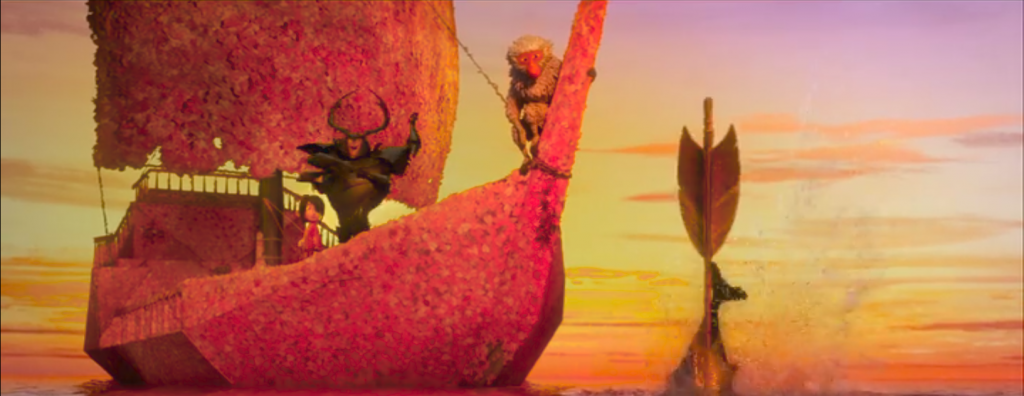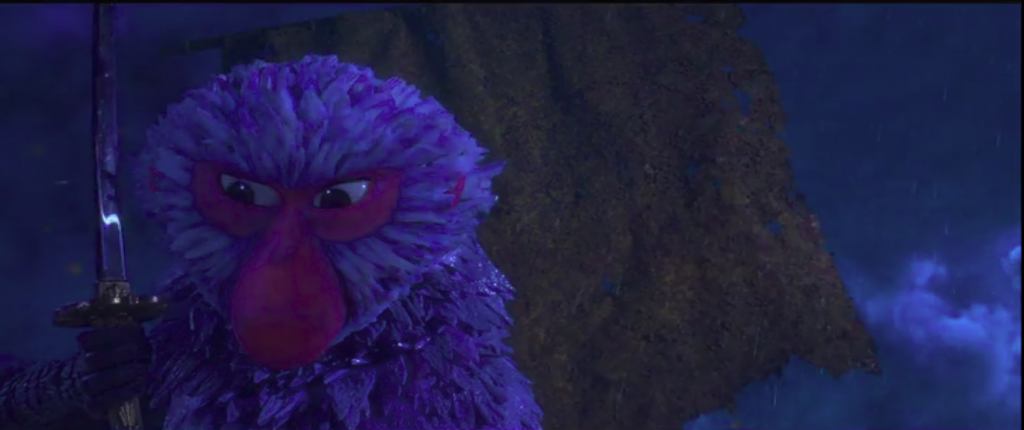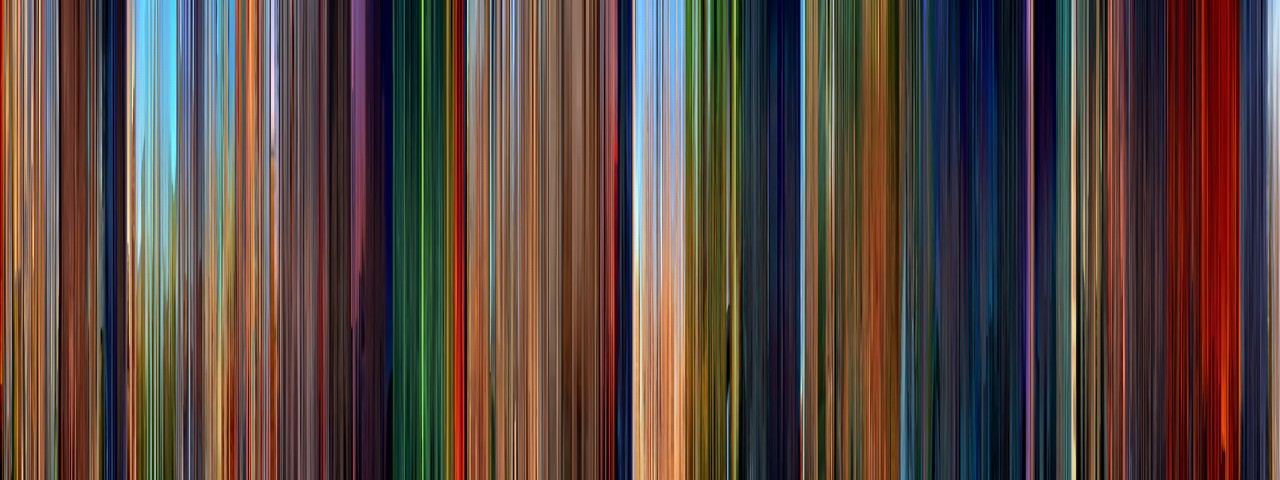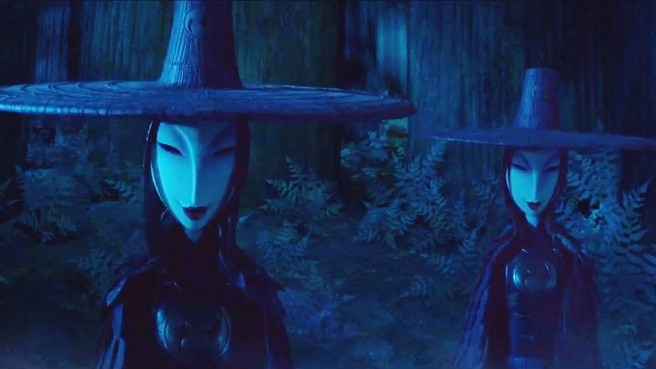Animation company Laika has produced four animated feature films in the eleven years since its founding. Their most recent film is Kubo and the Two Strings (2016), telling the story of Kubo, a young boy living in feudal Japan with his mother, and his magic-filled quest to defeat his corrupted family. He is joined by Monkey, a charm brought to life, and Beetle, a samurai and friend of Kubo’s late father who has been cursed to live as an insect. Together, they must collect three pieces of legendary and magical armor: The Sword Unbreakable, The Breastplate Impenetrable, and the Helmet Invulnerable.
One particularly memorable scene in the film, and arguably the turning point in the plot, is when Kubo and his two guardians-slash-teammates, Monkey and Beetle, discover the location of The Breastplate Impenetrable. The scene begins on a ship made of fallen leaves and is backdropped by a setting sun; Kubo, Monkey, and Beetle are bonding over freshly caught fish and intimate conversation — it is entirely a warm and peaceful scene. Like a hug from a loved one.

But the setting sun reminds us that night is soon to arrive. And with it, the powerful sisters that are determined to put a stop to Kubo’s quest — and steal his remaining eye. From the beginning, the audience knows that the moon surely brings trouble, as Kubo’s mother warns him outright that the Moon King, Kubo’s grandfather, is dangerous and Kubo must be inside by the time night falls. The film’s plot is even set into motion when Kubo inevitably does stay out past sundown and encounters his two vicious (and, frankly, unsettling) aunts. Every following scene with the two sisters occurs at night, leading the audience to understand that nightfall and the full moon bring danger. So while the lighthearted scene above is going on, the audience is thinking “this is nice and all, but maybe you should go find cover somewhere?”, creating suspense.

Finally, the sun does set and a sister, of course, arrives to start trouble, just as the audience had feared. Kubo and Beetle have both disappeared underwater, in search of the breastplate, leaving Monkey all alone to fight the sister. In total contrast to the scene minutes before, the audience is now worrying about the safety of all three of our heroes. Rightfully so, as the fight ends with Monkey gravely wounded and secrets revealed. And although this battle and the warm hug from earlier occur in the exact same setting, Kubo’s ship in the middle of the Long Lake, the emotions the two scenes give off are complete opposites. This is exemplified both in the content of the scene (as is to be expected) and in the color palettes of each.

I went ahead and color-picked a palette for each scene, focusing mainly on the colors of the ship. On the left is the daytime scene, full of warm hues and muted tones. The nighttime scene, on the right, gives us cold and dark colors, in direct opposition of the left. And yes, nightfall does cause bright colors to darken, but it was no accident that the reds and oranges of the leaf ship become dark blues and purples as the mood shifts.
Even without knowing the plot, without seeing the visuals or hearing the dialogue, a person can tell that there is a drastic shift simply from looking at the color palettes. Take this “movie barcode” for example:

It’s every frame from a film condensed into one image. Can you tell what movie it is? I’d bet not. But, I’d bet that you can tell when a scene shifts, when the mood changes, and when the climax occurs. Color plays a major role in how movies are viewed nowadays, it provides another layer or element that black and white movies just don’t have. This specific barcode is for The Lion King, for those wondering.
This color dichotomy is present through Kubo. The protagonists, Kubo, his mother, Monkey, and Beetle, all have warm colors as a part of their character design. All the antagonists, the Moon King and the two sisters, are made up almost entirely of cool colors. This serves to further the day/night, good/evil motifs and gives the audience certain expectations for when those colors appear later.
Another motif present throughout the film is the use of eye imagery. The opening line of the film is “If you must blink, do it now.” Kubo is missing an eye, the Moon King wants to steal his other eye, Kubo’s mother and Monkey both have a scar over one of their eyes, the Moon King is completely blind, and both of Kubo’s aunts wear masks that cover the entirety of their faces. Heck, there’s even an entire Garden of Eyes at the bottom of the lake that attempts to hypnotize our hero! The imagery is everywhere.


Eyes have always been considered the “windows to the soul”, and it is revealed that the reason Kubo’s grandfather wants his other eye is to prevent Kubo from seeing the good in the world and the people around him. Kubo’s mother has been punished by her family for seeing the good in humanity, in the form of Kubo’s father, and Kubo is the physical manifestation of her betrayal. This isn’t the first time Laika has shown their love for eyes — their first feature, Coraline, also used the idea that the loss of eyes leads to the loss of humanity when Coraline’s other-mother asks her to replace her eyes with buttons. Although, Coraline doesn’t have the same sheer amount of eye imagery as Kubo does.
Kubo and the Two Strings is a beautiful work of art and, in my opinion, Laika‘s best film to date. It’s currently streaming on Netflix, and I highly recommend that you go watch it immediately.

Sources Referenced:
Barsam, Richard, and Dave Monahan. Looking at Movies: An Introduction to Film. W.W. Norton and Company, 2016.
Kubo and the Two Strings. Directed by Travis Knight. Laika, Focus Features, 2016.
Moviebarcode. The Lion King (1994). Tumblr. 2011,
moviebarcode.tumblr.com/post/4388598352/the-lion-king-1994-prints.